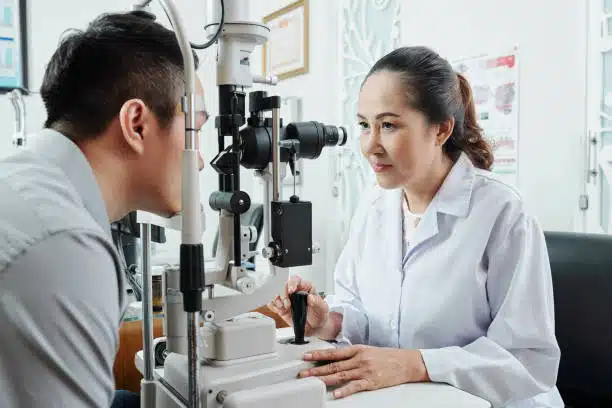Exploring the Newest Technological Advancements in Optometry and What They Mean for Optometrists
From the accuracy of Optical Coherence Tomography to the nuanced understandings offered by AI-driven analysis tools, these advancements are setting new requirements in individual assessment and therapy. As these developments permeate the technique, optometrists are faced with the difficulty of accepting these tools to improve client results.
Technologies in Diagnostic Equipment
Progressing the field of optometry, technologies in analysis devices have actually changed the way eye treatment professionals examine and identify ocular conditions and aesthetic problems. The past decade has witnessed significant technical innovations, making it possible for more exact and detailed analyses. Optical Coherence Tomography (OCT), for instance, provides high-resolution cross-sectional photos of the retina, permitting for the very early discovery of illness such as glaucoma and age-related macular deterioration. This non-invasive imaging strategy has ended up being crucial in modern optometric practice.
An additional trick development is the intro of sophisticated corneal topography systems, which map the surface area curvature of the cornea with accuracy. These tools are particularly valuable for fitting contact lenses and identifying corneal conditions. Furthermore, digital retinal imaging has transformed conventional ophthalmoscopy, supplying comprehensive, scenic sights of the retina that assist in thorough aesthetic assessments.
The growth of wavefront aberrometry has likewise been vital, making it possible for the evaluation of refractive errors with unparalleled precision (Optometrist Chino). This technology aids in tailoring rehabilitative lenses and improving surgical results for refractive surgical treatments. Collectively, these diagnostic developments encourage eye doctors to deliver remarkable person care, making sure early intervention and tailored therapy strategies, inevitably boosting aesthetic health outcomes
AI in Individual Monitoring
Building on the foundation of sophisticated diagnostic tools, the unification of man-made intelligence (AI) in individual monitoring represents a transformative leap for optometry. AI systems are progressively employed to improve effectiveness, precision, and customization in client care. By analyzing huge amounts of information, AI can determine patterns and forecast possible ocular conditions, allowing eye doctors to tailor interventions extra effectively. This capability is vital in taking care of persistent eye diseases such as glaucoma and diabetic person retinopathy, where early discovery and constant monitoring are key.
Furthermore, AI-driven systems help with streamlined client interactions and management processes. Automated scheduling, online consultations, and individualized follow-up strategies not just boost individual fulfillment yet additionally optimize time administration for practitioners. These systems can triage clients based upon the seriousness of their problems, guaranteeing that those in vital need get timely interest.
Furthermore, AI enhances decision-making by offering optometrists with evidence-based recommendations and treatment pathways. By integrating information from electronic health and wellness documents, AI tools use insights that notify clinical decisions, decreasing the risk of errors and enhancing individual end results. As AI remains to develop, its duty in patient monitoring will likely broaden, reshaping the landscape of optometric care.
Breakthroughs in Retinal Imaging
In the world of optometry, retinal imaging has seen impressive technological innovations that are improving analysis capacities and patient treatment. Developments such as Optical Comprehensibility Tomography (OCT) and fundus digital photography have revolutionized exactly how eye doctors envision and evaluate the retina.
Boosted imaging techniques like OCT angiography are more refining analysis accuracy. Eye Doctor. Such improvements promote the recognition of minute retinal modifications that might symbolize illness development.
Furthermore, innovations in artificial knowledge are boosting retinal imaging by allowing computerized analysis of large datasets. These systems assist eye doctors in recognizing patterns indicative of pathology, consequently enhancing diagnostic accuracy and performance. Collectively, these innovations are transforming retinal imaging right into a foundation of contemporary eye treatment, enhancing end results and increasing restorative possibilities.
Teleoptometry's Growing Function
Teleoptometry is increasingly becoming a vital element of eye treatment, driven by innovations in data and analysis tools. As optometry embraces electronic makeover, teleoptometry assists in remote assessments, enabling optometrists to expand their solutions beyond standard boundaries. This is specifically valuable in underserved and country areas where access to specialized eye care is often limited. By leveraging high-resolution video conferencing and advanced retinal imaging, optometrists can conduct extensive eye tests from afar, guaranteeing prompt medical diagnosis and treatment.
The integration of expert system (AI) more improves teleoptometry, making it possible for the evaluation of aesthetic data and aiding in the detection of eye problems such as glaucoma and diabetic person retinopathy. AI-powered algorithms can swiftly interpret intricate imaging data, providing optometrists with important understandings that boost clinical decision-making.
Moreover, teleoptometry sustains continuity of care through seamless integration with digital health and wellness documents (EHRs), enabling optometrists to preserve comprehensive individual histories. When seeking advice from with different professionals., this guarantees that clients obtain constant and individualized care also.
Despite these advantages, difficulties remain, consisting of guaranteeing data security and handling person assumptions. However, teleoptometry stands for a considerable stride towards more available, effective, and patient-centered eye care. As innovation evolves, its duty is positioned to increase further.

Future Patterns in Eye Treatment
A myriad of cutting-edge patterns is established to reshape the future of eye treatment, driven by technological advancements and the advancing requirements of individuals. One significant fad is the integration of fabricated intelligence (AI) in diagnostics, which official statement guarantees to boost the precision and performance of eye exams. AI algorithms can analyze large amounts of information from retinal images, possibly discovering conditions like diabetic person retinopathy and glaucoma earlier than typical approaches.
Furthermore, personalized medicine is obtaining grip in optometry, with hereditary screening educating personalized therapy strategies. This method intends to enhance client results by tailoring interventions to individual genetic profiles. Wearable innovation, such as smart get in touch with lenses, is additionally imminent, offering real-time surveillance of intraocular pressure or sugar levels, hence supplying continuous understandings right into systemic and ocular wellness.
The fostering of augmented fact (AR) and online fact (VR) in published here training and client education is an additional arising fad. These innovations use immersive experiences that can improve understanding and skills both for individuals and eye doctors. As these patterns evolve, optometrists need to stay abreast of technological improvements to supply cutting-edge care, ensuring enhanced individual end results and satisfaction in the vibrant landscape of eye care.
Verdict

Collectively, these analysis improvements encourage eye doctors to provide remarkable individual treatment, making certain very early treatment and tailored therapy approaches, eventually enhancing aesthetic wellness end results.

As these innovations proceed to progress, eye doctors must adjust and integrate them into image source technique, eventually maximizing operations efficiency and elevating the requirement of eye treatment provided to clients.